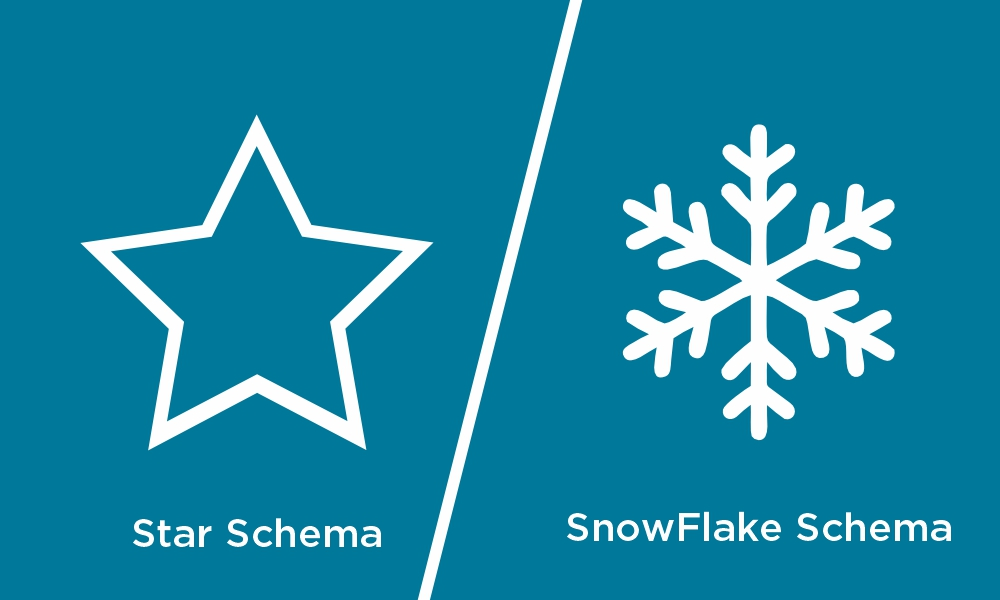Data is the most valuable asset today. From individuals to SMBs and big billion-dollar businesses, all generate data in some form or another. For example, the data we generate through social media or an organization with employee records. Moreover, we often need to save important data so that we can access it later.
So, here comes the point of data storage! Alongside that, information that needs to be used for analytics is stored in the data warehouse. In this scenario, it’s important to consider a few guidelines on how to structure the data to make it easy to handle and analyze. The data warehouse schema is mainly the arrangement of your tables and their connections inside a database or data warehouse.
The two popular ones are the star schema and the snowflake schema. To put it short, Star Schema is a simple form of data that’s easy to handle. On the other hand, Snowflake Schema is a complex method of storing that focuses on data integrity and storage efficiency.
Let’s understand both the key terms in detail, including their key differences, characteristics, and more, in this blog.
So, let’s get started.
What is a Star Schema?
A star schema is a type of multidimensional and straightforward method of arranging data in a data warehouse. It mainly consists of the fact table, which is at the center, storing quantitative data such as the number of transactions, net profit, etc. ‘
The fact table connects to the multidimensional denormalized tables that store information about descriptive attributes such as address, product names, etc. This creates a Star shape design with the fact table connecting to the dimension tables.
Characteristics of Star Schema:
- Follows a denormalized structure.
- Ideal for straightforward queries and reporting
- A foreign key is used to connect the dimension table to the fact table.
- Simple structure for users.
Benefits
- Fast query performance due to few joins
- Easier for data analysts to understand,
- Best for faster speed reporting
What is Snowflake Schema?
Snowflake schema is also a form of arranging data for data warehouses. It includes fact tables, dimension tables, and sub-dimensional tables. All these tables are connected by foreign keys that form a snowflake structure.
It further aims to normalize the star schema’s denormalized data. Normalization is the process of organizing data. In the end, a star schema is expanded upon by a snowflake schema. The snowflake gets its name from the highly structured, complex dimensions that have numerous relationships with one another.
Characteristics of Star Schema:
- It has a normalized data structure
- Impact on performance due to multiple tables.
- Snowflake schemas help reduce redundancy.
Benefits:
- Protects data integrity.
- Efficient query handling.
- Uses less storage space.
- Easy to maintain consistent data across dimensions
Differences Between Star Schema and Snowflake Schema
1] Architecture
When it comes to architecture, the star schema has a simple design. Here, all the dimension tables are denormalized and connected to the fact table. That’s easy to understand and work with your queries. On the other hand, in the snowflake schema as discussed above, the dimension tables are split into other sub-dimensional tables. This reduces the storage space and leads to complexities in queries.
2] Performance
Speed is the key to success! Star and snowflake schemas outperform in terms of speed. As all the dimension tables are connected directly to the fact table, queries have fewer joins, leading to best-in-class performance.
Compared with the snowflake schema, they are slow due to multiple tables. In short, to retrieve the data, you need to connect through the dimensional and sub-dimensional tables. So, these are not ideal when you need quick query performance.
3] Storage needs
Star schemas need more storage space as redundant data is stored in the dimensions of tables. For example, when multiple customers reside in the same city, the city name will be repeated, leading to redundancy and more storage space. Talking of snowflake schema, here it avoids redundancy, every data is stored only once. Also, there is a splitting of tables that assists in reducing space.
4] Use cases
When speed or quick results are needed, star schemas are the right option. It is ideal for reporting and online analytical processing (OLAP) applications. May be any type of report, such as, sales report, super quickly. While snowflake schema is ideal for financial analysis, CRM and more.
5] Maintenance
In star schema, updating attributes in the dimension table is easy, as you need to only make changes in one table. Conversely, in snowflake schema, changes in attributes need to be done across several tables, making it complex to maintain.
Factors to Consider Before Choosing the Best Schema
The following are the factors you can consider before choosing the right Schema for your organization's tasks.
- Data complexity
- Maintenance
- Query performance needs
- Storage space
Star Schema vs Snowflake Schema: Which is Right for You?
- If you need to handle small volumes of data and speed is the priority, then consider going for a star schema.
- If you need complex data, with frequent changes and less storage, Snowflake Schema is the right option.
Concluding Part
Star schema vs snowflake schema plays a crucial role in data warehousing. If you need speed and simplicity, then, as discussed above, the star schema is what you should consider. On the other hand, if you need to focus on efficiency and data integrity, consider going for the Snowflake schema. After all, the choice all depends on your needs and requirements for the data warehouse. I hope the above blog has helped!
No matter if you’re a tech enthusiast or a newbie looking to upgrade your knowledge, we’ve got you covered with all the blogs covering diverse tech, marketing, business, AI, ML and more. So, don’t wait! Head over to our site now!
Frequently Asked Questions
1. Is the star schema better?
Answer: To share in simple words, the star schema is widely considered over the snowflake schema due to its simplicity, faster query execution speed, easy maintenance, and more.
2. What is the difference between a dimension and a fact table?
Answer: A fact table contains quantitative data about a business, while a dimension table contains qualitative data or descriptive data that gives context to the data in a fact table.
3. What is a star schema in ETL?
Answer: A multifaceted data model called a star schema is used to arrange data in a database in a way that makes it simple to comprehend and examine.
Recommended reads:







